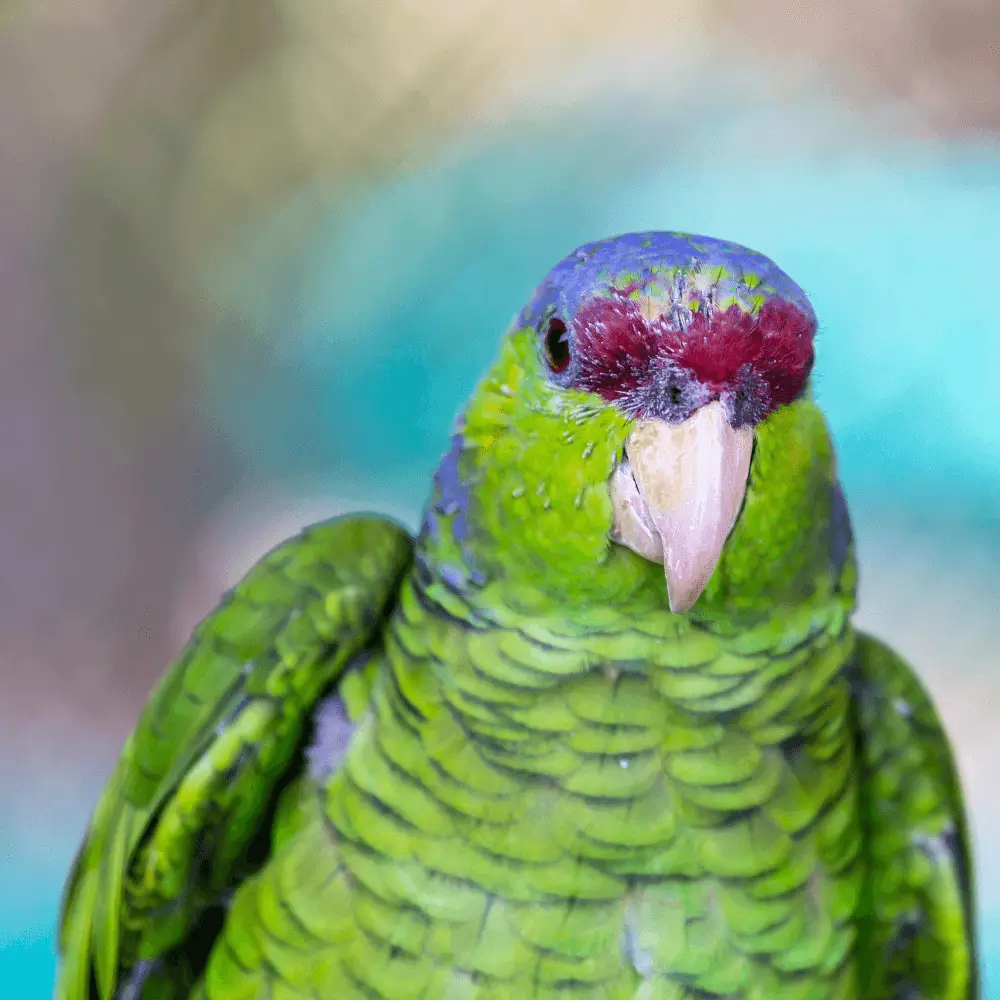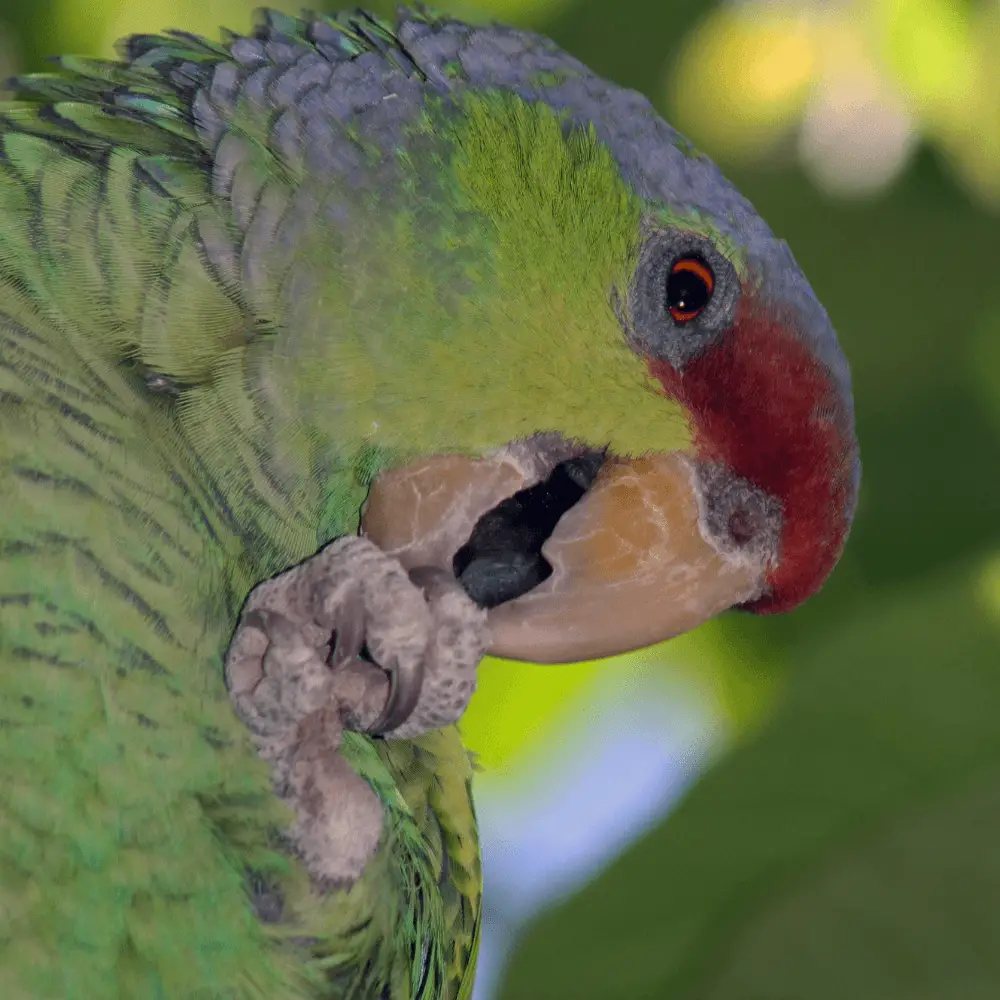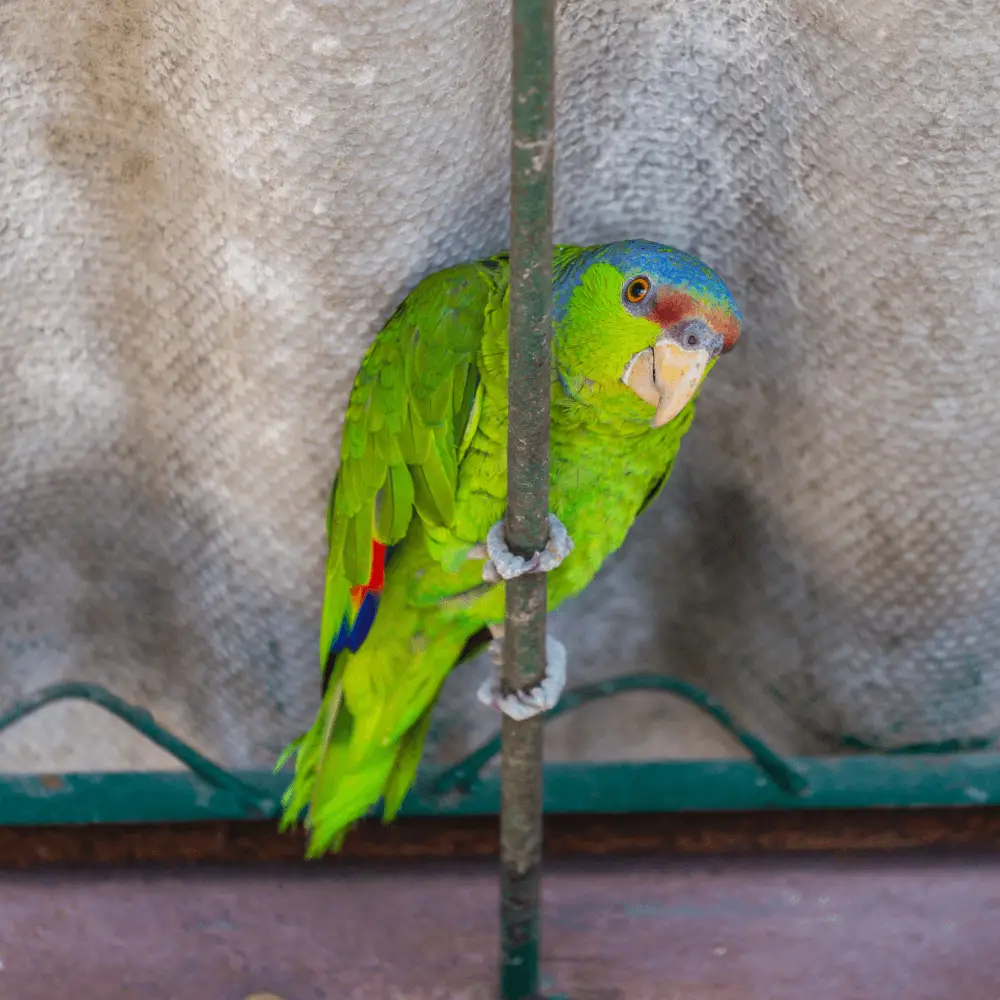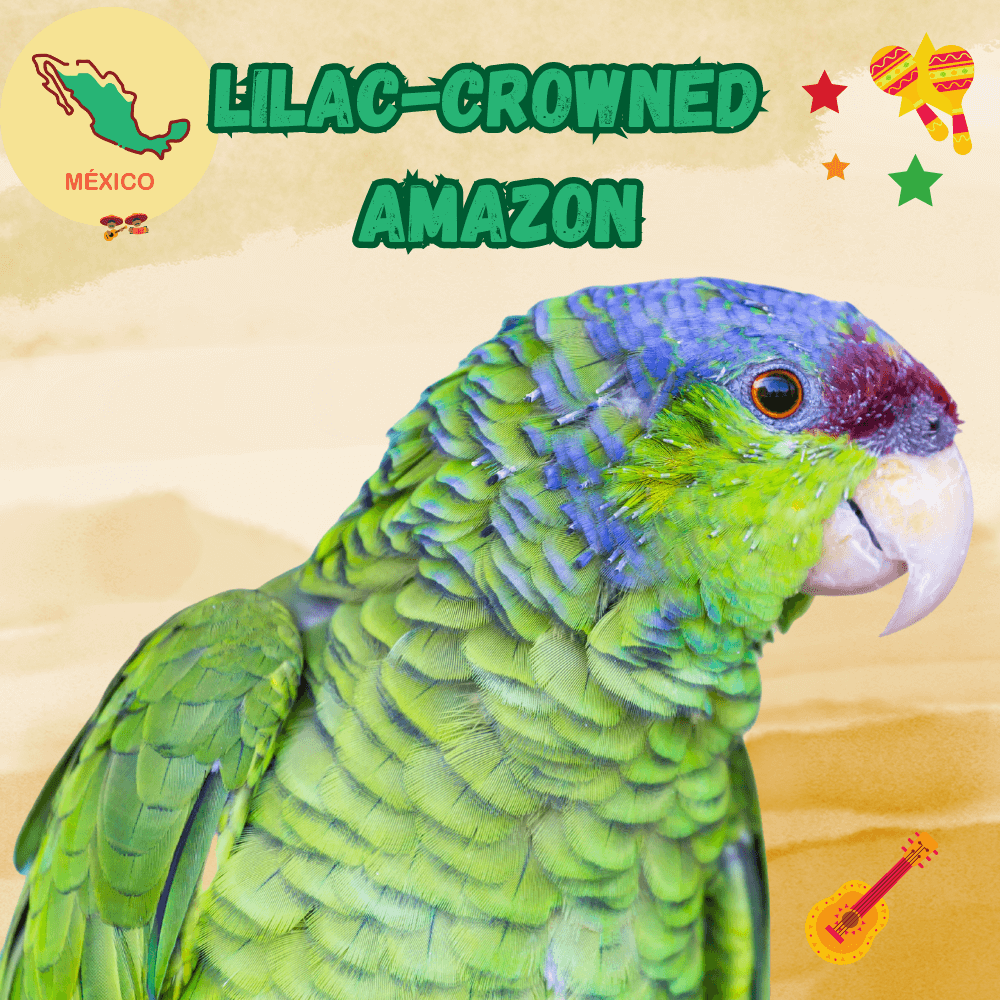Lilac-crowned Amazon: 33 cm head to tail and weighs an average of 310 grams. The Lilac-crowned Parrot (Amazona finschi) has the front and upper lords, off red; the lower Lords, the cheeks and the ear-coverts, pale lime green; crown, sides neck yes nape, lilac or pale blue with few crown feathers showing narrow black margins.
Green mantle with large black edges which give a visible scaly effect; back Yes low green collars with black borders to a few feathers; Grupa Yes Uppertail-coverts, green, slightly brighter than the back. wing covers green.
Primary blue towards the tip, Green in the base; the base outer networks the first five secondary, red subterminal band yellow and blue, secondary tips, second, green, turning blue at the tip. under the wings, yellow-green; green color matte flight feathers.
- Order: Psittaciformes
- Family: Psittacidae
- Genus: Amazona
- Scientific name: Amazona finschi
- Citation: ( Sclater, PL , 1864)
- Protonimo : Chrysotis finschi
- Origin: Mexico
- Character: Sociable
- Longevity: Over 30 years.
- Height: 33cm.
Lilac-crowned amazon habitat

mainly at altitudes of 600 to 2,000 m, but recorded at sea level Sinaloa and from sea level at Colima temperate forest. observed between 360-1,700 meters in Sonora Yes 880-1,480 meters in Oaxaca.
Usually in pairs or small groups, large groups are formed in the dry season (500 birds reported) and in communal roosts (over 1,000 birds reported in the same Nayarit location ).
Distribution
The lilac-crowned parrot inhabits the Pacific Coast of Mexico, from the southeast end of Sonora and Southwest Chihuahua, south through Sinaloa, Western Durango, Nayarit, Jalisco, Colima, Michoacán Y Guerrero, west to Oaxaca . of Isthmus of Tehuantepec.
Lilac-crowned amazon mostly residential, but outside the breeding season, visit during the lowlands in autumn, for example in Oaxaca. generally common. Described as fairly common locally in southeastern Sonora. abundant in Colima. Very rare in the highlands of Oaxaca. Several wild populations have been reported from several locations in the United States.
Reproduction

They nest in hollow trees (e.g., ficus ), including old woodpecker nests (e.g., Phloeoceastes ) or arboreal termite mounds.
The breeding season includes from February to June, nesting with a cycle consisting of 28 days of incubation eggs, followed by two months of growth of the chickens in the nest ( Forshaw 1989, Renton 1998, 2002 ).
Food
Food habits are poorly documented: A particular preference for figs has been observed. During the dry season, the diet consists mainly of Astronium graveolens, Brosimum alicastrum, Celaenodendron mexicanum, Comocladia engleriana Yes Ficus insipida.
During the rainy season The diet consists of species such as Caesalpinia pulcherrima, Celaenodendron mexicanum, Esenbeckia nesiotica, Jatropha spp Yes Sciadodendron excelsum (Renton 1998, 2001 )
cause some damage to maize and banana crops.
Endangered

• Current IUCN Red List Category: Endangered.
• Demographic trend: Degressive.
• Population size: 4700-6700.
The rationale for Red List Category
Lilac-crowned amazon has been selected as Endangered because it is suspected that it is declining very rapidly based on recorded contractions of beaches and due to unsustainable exploitation and habitat loss.
Population justification
Renton and Elias (2003) estimate the global population at between 7,000 and 10,000 individuals, based on surveys covering most of the species’ global range. This equates to approximately 4,700-6,700 mature individuals.
An estimate of 5,400 individuals each year are illegally captured in Mexico ( Cantu et al., 2007 ), implies that the Renton and Elias (2003) population estimate might be an understatement, but this assessment rests with the best available data.
Justification of the trend
Threat
Capturing it for national and international trade is the greatest threat to wild populations.
• It is highly valuable in trade (Cantu et al., 2007) and it was the most attractive genus of the Amazon parrot in the early eighties ( Inigo-Elias y Ramos 1991 ).
• The illicit trade is intense and widespread, and the Lilac-crowned Parrot is one of the most frequently confiscated Mexican parrots ( K. Renton, in litt., 2005 ).
• During the period 1981-2001, were recorded 4.061 individuals in international trade, of which 79% were exported directly from Mexico and 64% took Nature ( 2004a CITES ).
• Remains one of the five most taken Mexican parrot species, with an estimated 5,400 individuals/year taken illegally in Mexico ( Cantu et al., 2007 ).
• Los Adults and young are easily trapped in large numbers due to their habit of congregating in communal shelters in the late afternoon ( Renton 2005, K. In some Renton 2005 ).
• Chicks are usually poached from nests ( K. Renton, in litt., 2005 ).
• In interviews with local people across the range of the species, 75% of poaching is reported in your area ( K. Renton, in litt., 2005 ).
• Furthermore, it is said that this species requires semi-deciduous forest with tall mature trees for nesting and cannot adapt to modified nesting areas ( worm Marin-Togo et al., 2012 ).
• habitat loss and degradation, mainly for conversion to small and large crops and pastures ( K. Renton in some. 2007, A. Salinas in some. 2007, Ortega-Rodriguez and Monterrubio-Rico 2008 ), are serious threats, with semi-deciduous forest along the Pacific coast being lost at a higher rate than any other forest type in Mexico ( Masera et al., 1996, K. Renton, in litt., 2005 ), It results in the destruction of nesting sites and reducing the extent of this critical habitat ( Renton 2005 ).
• In Michoacán, potentially more accessible nesting areas, such as plains or hills, have been converted into livestock or agricultural farms ( Ortega-Rodriguez and Monterrubio-Rico 2008 ).
• Large development projects, such as dams, In addition, they have resulted in the loss of breeding habitat for the species ( K. In some Renton ., 2007 ).
• The semi-deciduous forest only covers 5,106 km2 in the range of species ( Renton and Elias 2003, K. Renton, in litt., 2005 ).
• The decrease in rainfall that could result from global climate change would lead to a decrease in the reproductive potential of wild populations in dry tropical forests ( K. In some Renton., 2007 ).
• Despite the various pressures on the habitats, by showing that the species has disappeared from more than 70% of its former range, Marin-Togo et al. (2012), reinforced the idea that capture pressure is the main threat to the species.
Current conservation actions

• In 1999, the Mexican government established a Conservation Plan, Protection and Recovery Psitácinos in Mexico, in which the Lilac-crowned Parrot is considered a priority species ( Macias Caballero et al ., 2000 ).
• In 2004, the species was updated to Appendix 1 of CITES, and in 2007 It approved a proposal to change its Species Conservation Status 2008 from “ Threatened ” to “ Endangered ” under the Conservation Act. Mexican Fauna ( K. In some Renton. )
• In Mexico, they have made considerable efforts to combat illegal domestic trade, with at least 52 seizures during 1997-2003 (CITES 2004b).
• The inspections carried out in Mexico resulted in the seizure of 266 live individuals of the species that were offered illegally in the pet trade between 1995 Yes 2003 (2004b CITES).
• The species It is in three biosphere reserves; Sierra de Álamos-Río Cuchujaqui Flora and Fauna Protection Area in southern Sonora, and the Reserva de la Biosfera Chamela-Cuixmala and the Sierra de Manantlán Biosphere Reserve, in Jalisco, and according to sources, It is distributed in seven other Important Bird Areas; however, some of them do not have formal protection or conservation programs ( CITES 2004a )
Proposed conservation measures
• Monitor demographic trends through regular surveys.
• Monitor levels of habitat destruction and degradation.
• Implement trade regulation strategies in the 1999 plan.
• Carry out extension works and environmental education as described in the 1999 plan.
• Carry out habitat conservation and restoration of wild populations as recommended in the 1999 Plan.
• Monitor the success of the strategies of the 1999 plan.
• Protect remaining tropical forest supports in areas where the slope is greater than 6°: ideally, all areas on steep slopes should be restored to the forest, to provide habitat for all wildlife species (including the Amazon to lilac wreath )
• Prevent soil erosion AND promote alternative economic activities in rugged coastal areas such as recreation and tourism. ( Ortega-Rodriguez and Monterrubio-Rico 2008 ).
Lilac-crowned Amazon in Captivity
Very popular as a pet throughout its range; It has cultural value as an ornamental animal or bird through its feathers; ability to imitate sounds and its tendency to form bonds with people; widespread in captivity internationally.
Currently protected by CITES Appendix 1.
Each captive copy of this species, which is capable of reproducing, should be placed in a well-managed captive breeding program and not sold as a pet, in order to ensure their long-term survival.
SOURCE: FOX 35 Orlando
Related article:

